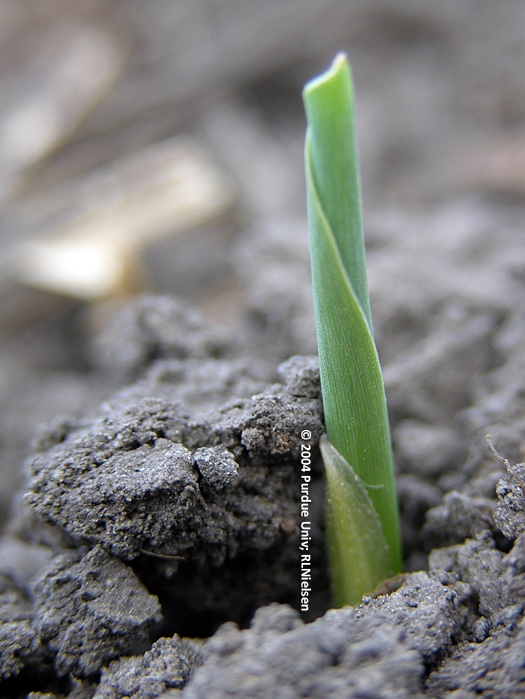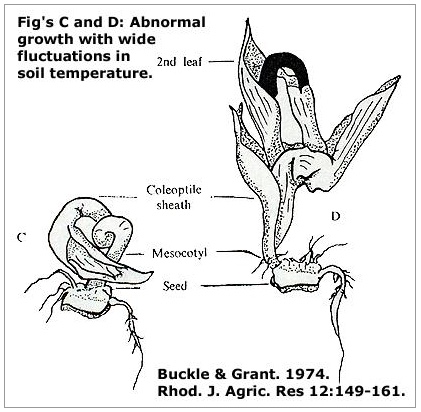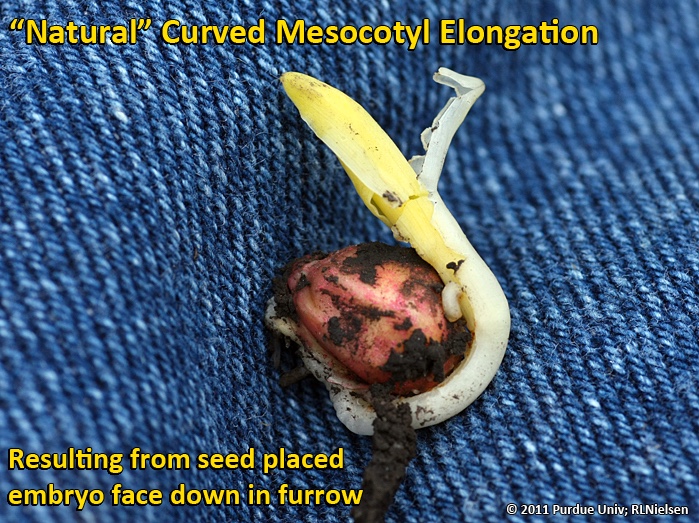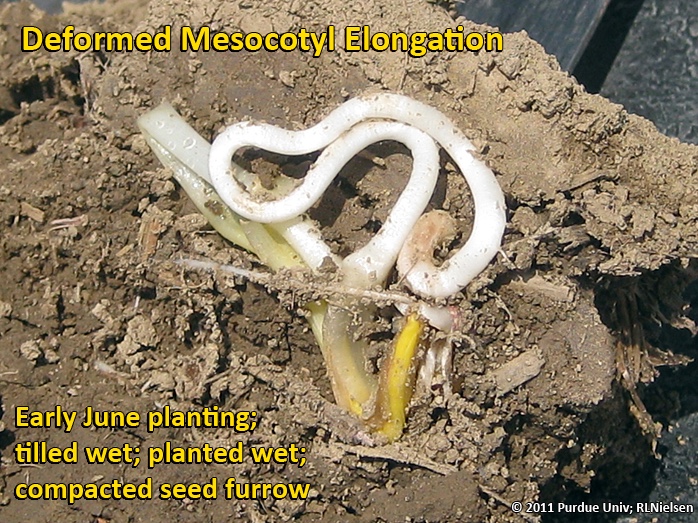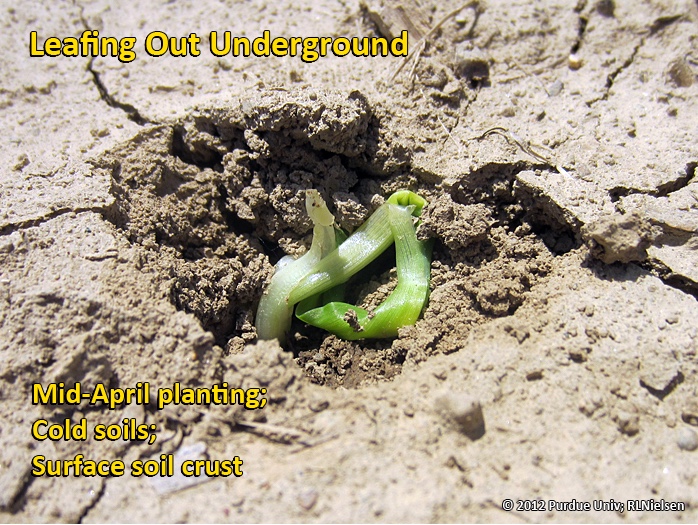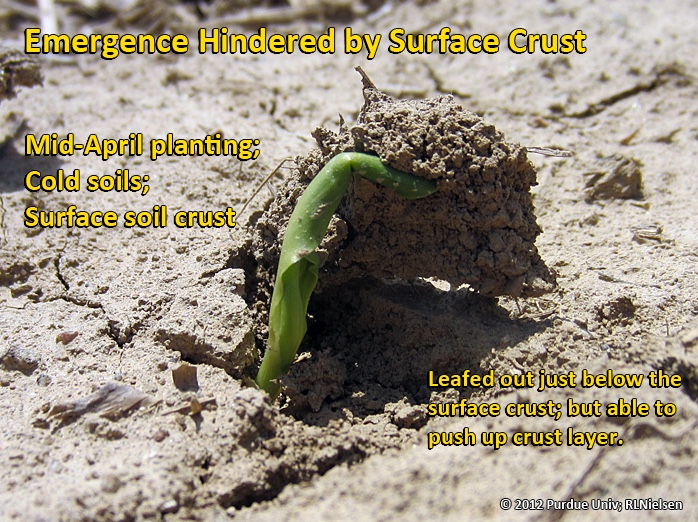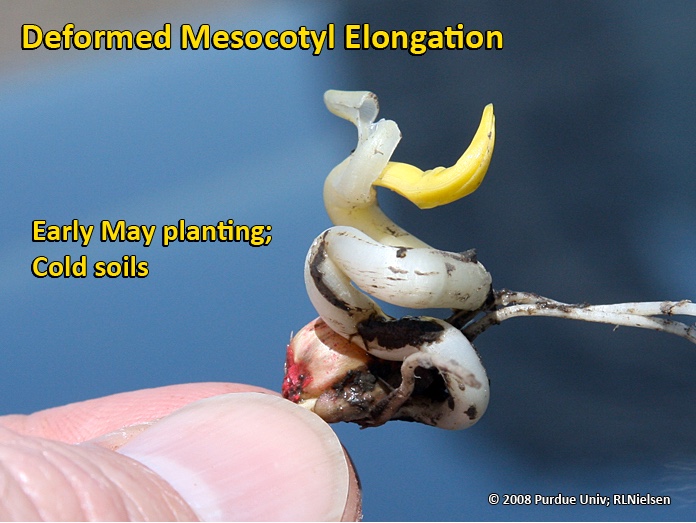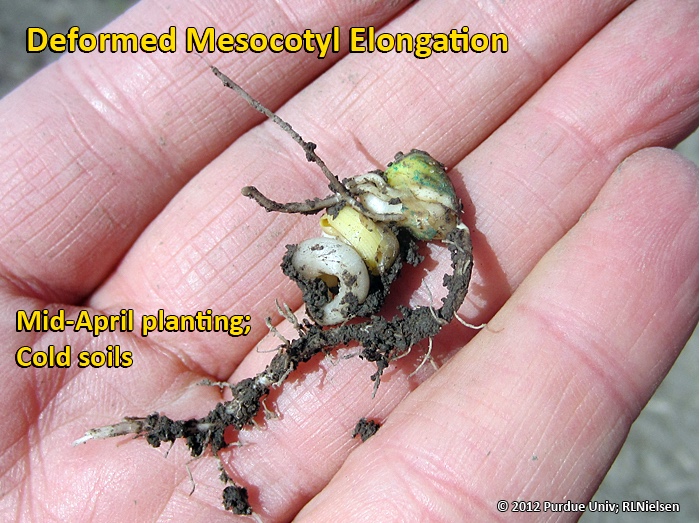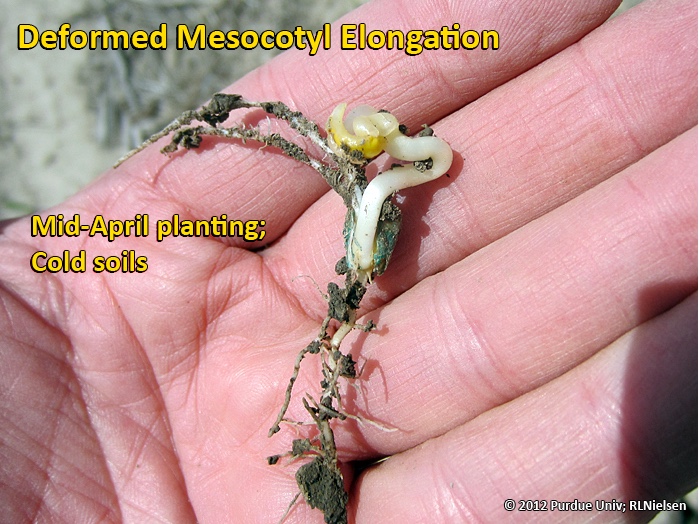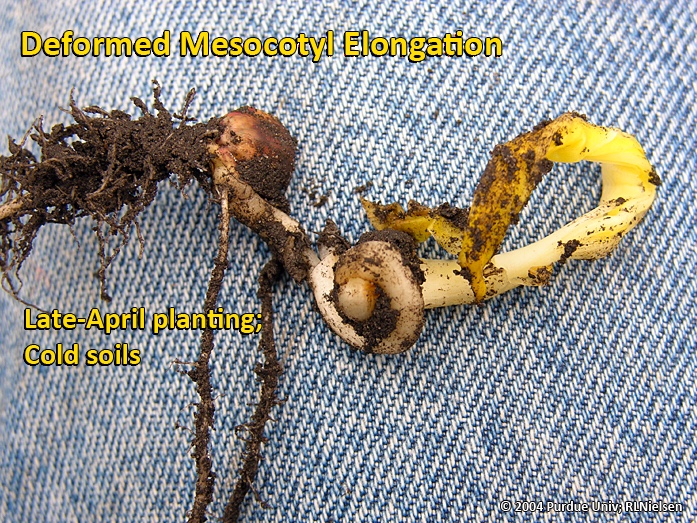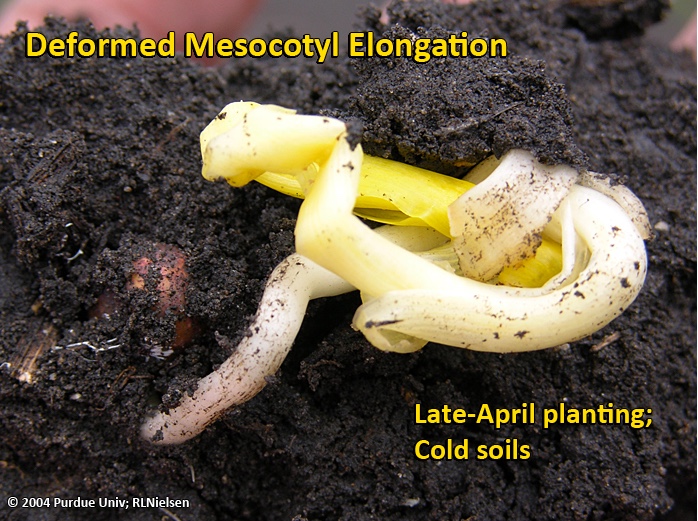Successful stand establishment of a corn crop relies on many factors, including the successful emergence of the seedlings in the first place. Seedling emergence occurs as a result of elongation of the mesocotyl that elevates the coleoptile or “spike” toward the soil surface. If successful, the appearance of the coleoptile at or near the soil surface is synchronized with the emergence of the first true leaf from inside the coleoptile.
The mesocotyl is the white tubular stem-like plant part located between the kernel and the base of the coleoptile. Technically, the mesocotyl is the first true stem internode of the young corn seedling. As the coleoptile nears the soil surface, exposure to the red wavelengths of solar radiation causes a change in the supply of one or more growth hormones from the coleoptile to the mesocotyl tissue and mesocotyl elongation comes to a halt (Vanderhoef & Briggs, 1978).
If mesocotyl elongation and/or coleoptile emergence are compromised, the emergence of the leaves from the coleoptile may occur underground and the leaves remain trapped by the soil. Such “leafing out underground” is obviously viewed with great consternation by growers who were hopeful for perfect emergence of their crop. Emergence failure directly reduces the productive plant population; one of the major yield components of corn, and so grain yield potential may be unacceptably decreased if the productive plant population is substantially lower than the optimum population. Uneven seedling emergence and/or development effectively also decreases the productive plant population. See Nielsen et al. (2019) for guidelines on optimum plant populations for corn in Indiana.
Failure to emerge successfully can be caused by failure of the germination process itself, failure of the mesocotyl to successfully elongate and/or by soil restrictions that hinder successful penetration of the soil by the coleoptile. In extreme cases, elongation of the mesocotyl fails miserably, resulting literally in corkscrewed fiascos. Often, more than one of the following causal factors exist in a problem field and usually interact with each other to amplify the problem.
Herbicide Injury: Certain herbicides, notably cell growth inhibitors like acetochlor, can affect seedling shoot development especially if weather or soil conditions are not conducive for rapid seedling growth. See Hartzler and Anderson (2018) for more information. However when herbicide injury is suspected to be a contributing factor, cool soils and dense soil crusting are often also contributing factors, so is difficult to pin the blame completely on the herbicide injury.
Insect Injury: Certain soil-borne insects like seedcorn maggots (Delia platura) and wireworms (Agriotes, Limonius, etc. spp.) occasionally feed on corn kernels in the seed furrow, destroying or injuring the embryo in the process. Kernel symptoms from this type of injury are fairly obvious. See linked sites below in the Reading List for more information.
Disease Injury: Fungicidal seed treatments effectively prevent most seed rots and seedling blights for 2 to 3 weeks after planting. However, once the seed treatments deteriorate with time, fungal diseases like Pythium and Fusarium may infect the seed or young seedling, causing stunted development or outright death (Sweets, 2015). Kernel or seedling symptoms from these types of diseases are fairly easy to identify.
Kernel Position in Furrow: The coleoptile, the protective covering for the plumule leaves, emerges from the embryo side of the kernel and elongates in the direction of the dent end of the kernel by virtue of the elongation of the mesocotyl. The position of the kernel in the furrow with respect to the embryo face therefore directly influences the initial location where the coleoptile emerges. If the kernel lands with the embryo face down in the furrow, the coleoptile emerges on the bottom side of the kernel, elongates horizontally until the mesocotyl “clears” the end of the kernel, then finally begins its upward ascent. Such an “upside-down” beginning might contribute to a seedling’s susceptibility to other corkscrewing causal factors.
Restricted Emergence: Corkscrewed mesocotyl/coleoptile development can occur when the coleoptile encounters resistance as the mesocotyl elongates. Severe soil crusting or otherwise dense soil surface and cloddy soil surfaces can cause such resistance. A combination of severe sidewall compaction plus press wheel compaction over the furrow can also restrict coleoptile emergence and force the mesocotyl to elongate in unusual directions.
Cold Soils: Cold soils and/or wide fluctuations in soil temperatures throughout the day during the emergence process are also thought to be major contributing factors for the development of “corkscrewed” mesocotyl development (Buckle & Grant, 1974). The nature of the cold temperature injury appears to be damage to the outer surface layers of the mesocotyl. The elasticity of the damaged tissue is less than healthy tissue. The “corkscrew” elongation of the mesocotyl occurs when the tissue damage occurs unevenly around the circumference of the mesocotyl. The exact minimum soil temperatures that can cause such corkscrewed development are not clearly documented, but clearly it is not uncommon in Indiana for daily soil temperatures to dip as low as 40F (4.5C) during April and early May. Furthermore, bright sunny days can elevate bare soil temperatures quite high but still drop quite low the following night and thus result in a wide diurnal fluctuation in soil temperatures. Dry soils would be more prone than wetter soils to wide swings in daily soil temperatures.
Imbibitional Chilling Injury: Cold temperature injury that results in corkscrewed mesocotyls is not exactly the same as that which is referred to as “imbibitional chilling” injury. The latter refers to cold injury to the seed that occurs during the first 24 to 36 hours after planting as the dry seed imbibes (aka absorbs) water. The seed naturally swells in response to the imbibition of water. Cold seed cell tissue is less elastic and subject to rupturing as the seed swells. The threshold seed tissue temperature below which imbibitional chilling injury may occur is not clearly defined in the research literature, but appears to be temperatures cooler than 50F (10C). The most common symptom of imbibitional chilling damage is often simply swollen seed with little to no evidence of sustained germination progress. In contrast, seedlings with corkscrewed mesocotyls probably germinated successfully and subsequently experienced cold temperature injury to the mesocotyl tissue that interfered with normal mesocotyl elongation.
Related reading
Buckle, Janet and Penelope Grant. 1974. Effects of Soil Temperature on Plumule Growth and Seedling Emergence of Maize (Zea mays L.). Rhod. J. Agric. Res. 12: 149-161.
Hartzler, Bob and Meaghan Anderson. 2018. May Maize Maladies. Integrated Crop Management, Iowa State Univ. https://crops.extension.iastate.edu/blog/bob-hartzler-meaghan-anderson/may-maize-maladies [URL accessed Apr 2019]
Licht, Mark and Clarke McGrath. 2014. Imbibitional Chilling and Frost Damage to Corn and Soybean Seedlings. Integrated Crop Management News, Iowa State Univ. https://crops.extension.iastate.edu/cropnews/2014/05/imbibitional-chilling-and-frost-damage-corn-and-soybean-seedlings [URL accessed Apr 2019].
Nielsen, RL (Bob). 2014. The Emergence Process in Corn. Corny News Network, Purdue Univ. http://www.kingcorn.org/news/timeless/Emergence.html [URL accessed Apr 2019].
Nielsen, RL (Bob), Jim Camberato, and Jason Lee. 2019. Yield Response of Corn to Plant Population in Indiana. Corny News Network, Purdue Univ. http://www.kingcorn.org/news/timeless/CornPopulations.pdf [URL accessed Apr 2019]
Purdue IPM. Seedcorn Maggot. Purdue Univ. Field Crops IPM. https://extension.entm.purdue.edu/fieldcropsipm/insects/corn-seedcorn-maggot.php [URL accessed Apr 2019]
Purdue IPM. Wireworms. Purdue Univ. Field Crops IPM. https://extension.entm.purdue.edu/fieldcropsipm/insects/corn-wireworms.php [URL accessed Apr 2019]
Sweets, Laura. 2015. Seed Decay and Seedling Blights of Corn. Integrated Pest Management, Univ. of Missouri. https://ipm.missouri.edu/ipcm/2015/5/Seed-Decay-and-Seedling-Blights-of-Corn [URL accessed Apr 2019]
Vanderhoef, Larry N., and Winslow R. Briggs. 1978. Red Light-inhibited Mesocotyl Elongation in Maize Seedlings. I. The Auxin Hypothesis. Plant Physiology 61: 534-537.


